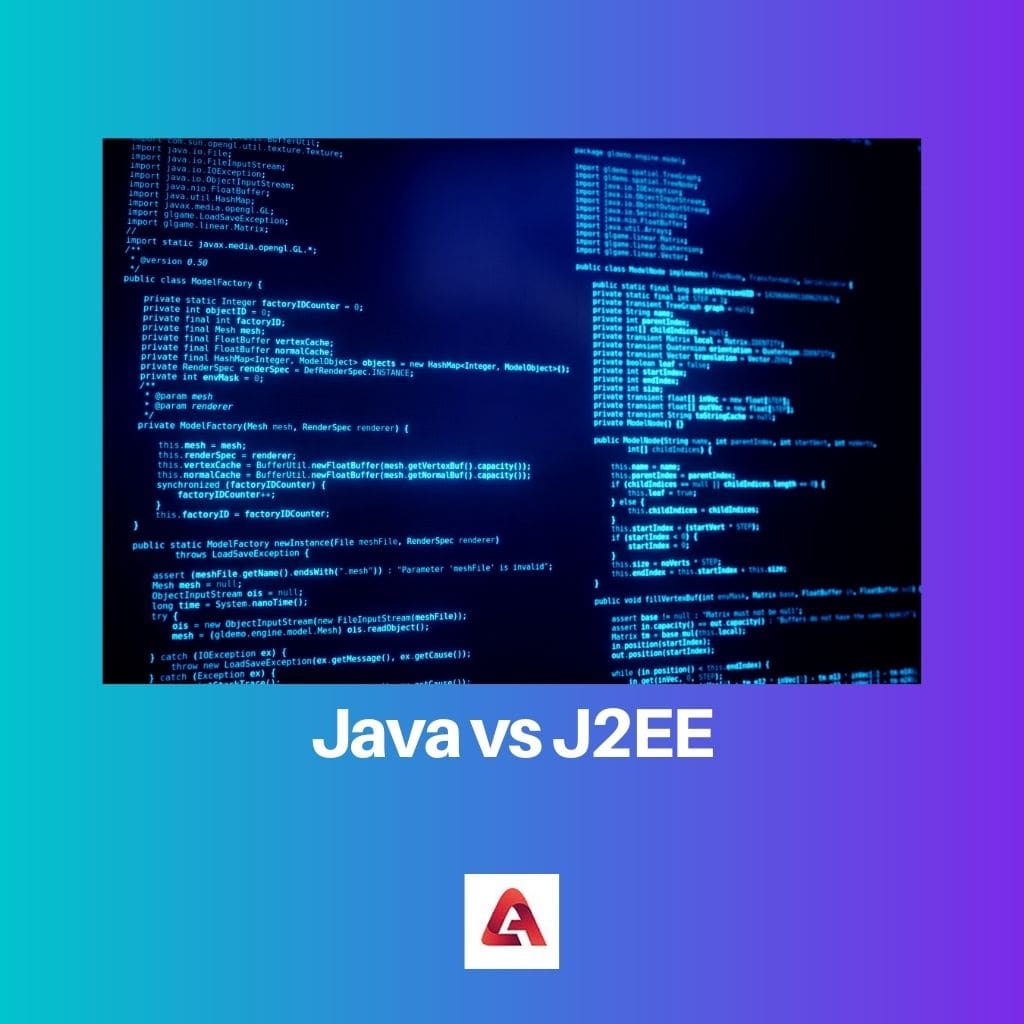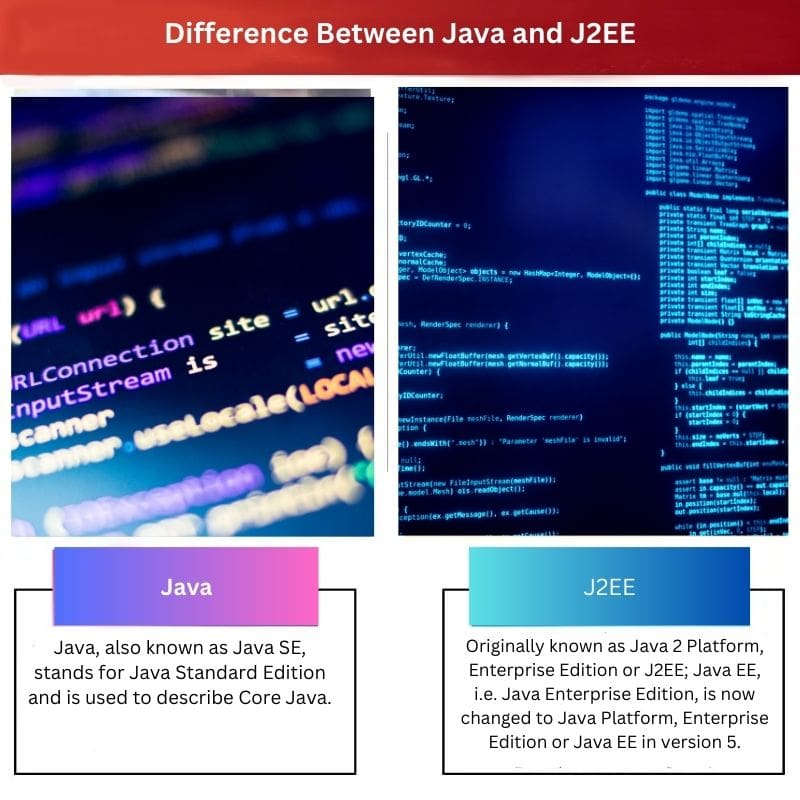Java is a class-based programming language derived from C and C++ and is a strictly object-oriented computer language used for desktop applications, game development, etc.
On the other hand, J2EE is based on Java programming language and is mainly used for web applications and services.
Key Takeaways
- Java is a versatile, object-oriented programming language for developing various applications, including web, mobile, and desktop applications.
- J2EE (Java 2 Platform, Enterprise Edition) is a set of specifications, services, and protocols built on top of the Java language, designed to develop enterprise-level applications.
- Java and J2EE are related to software development, but Java is the core programming language, while J2EE is an extended platform for creating large-scale, multi-tiered applications.
Java vs J2EE
Java is an object-oriented computer language that is derived from C and C++, used in developing games and desktop applications. J2EE is a computing platform that is based on Java and is used to develop web applications and services. It was originally called Java 2 Platform, Enterprise Edition.

Comparison Table
| Parameter of Comparison | Java | J2EE |
|---|---|---|
| Terminology | Java, also known as Java SE, stands for Java Standard Edition and is used to describe Core Java. | Originally known as Java 2 Platform, Enterprise Edition or J2EE; Java EE, i.e. Java Enterprise Edition, is now changed to Java Platform, Enterprise Edition or Java EE in version 5. |
| Use | Used mainly for developing applications (desktop) | Used mainly for developing web-based enterprise applications that can be used for both desktops and websites. |
| Components | It has three main components, i.e. Java Virtual Machine (JVM), Java Development Kit (JDK), and Java Runtime Environment (JRE) | It contains Servlets and JavaServer Pages (JSPs), Enterprise JavaBeans (EJBs) and Java Database Connectivity (JDBC). |
| Platform | Java is one of the most famous high-level programming languages for developing web content. It’s designed to run on all JVM-compliant platforms and is considered a simplified version of C++. | One of the central core technologies of Java is J2EE. Its main use is to create server applications such as websites and web applications. |
| First versions | The first version of the Java Development Kit (JDK) came from JDK Alpha and Beta in 1995. | The First version of J2EE came in May 1998 by the name JPE while the next came on December 12, 1999, by J2EE 1.2. |
What is Java?
One of the most popular and known languages that are present everywhere in Java. It starts from web applications, web services, laptops, and computers to games, supercomputers, mobile phones and almost everywhere.
Initially, it was developed as software for electronic devices such as remote controls, microwaves, etc. James Gosling developed it at Sun Microsystems in 1991.
The main idea behind this was to create a language that worked neutrally in different environments on different CPUs. This gave rise to Java, one of today’s most famous and influential programming languages.
One of the fantastic features of this language is that it has fewer implementation dependencies and can be developed on any device. Java can be assembled into one standard bytecode that works on all devices with a prebuilt Java Virtual Machine (JVM).
It is convenient and easy to use and can run on all JVM-compliant machines, making the program run on any platform irrespective of the architecture.

What is J2EE?
Originally known as Java 2 Platform, Enterprise Edition; Java EE (Java Platform, Enterprise Edition) was developed by Sun Microsystems and later acquired by Oracle Corporation.
It developed 3 computing languages, i.e. Java EE (Java Platform, Enterprise Edition), Java Standard Edition (Java SE) and Java Micro Edition (Java ME).
J2EE is an extension of Java SE, i.e. it is developed using Java programming language. It is used for creating web-based applications.
It comprises a set of APIs, facilities, and customs that helps develop multi-tiered internet applications. It includes several technologies such as Servlets, Enterprise JavaBeans, etc.
It’s principally used for applications that can be obtained easily through browsers like Chrome, Firefox, etc. Additionally, It is used for developing internet-related applications on WWW (World Wide Web) by creating standardized modular components.
The design of J2EE ensures that developers do not face many complexities while developing applications through its services. As a result, they can create patterns for greater efficiency and reliability.
It has some APIs and Java EE core technologies making it very powerful.
Main Differences Between Java and J2EE
- Java, also known as Java SE, stands for Java Standard Edition, used to describe Core Java whereas Originally known as Java 2 Platform, Enterprise Edition or J2EE; Java EE, i.e. Java Enterprise Edition, is now changed to Java Platform, Enterprise Edition or Java EE in version 5.
- Java is used mainly for developing applications (desktops), while J2EE is primarily used for creating web-based enterprise applications that can be used for both desktops and websites.
- Java has three main components, i.e. Java Virtual Machine (JVM), Java Development Kit (JDK), and Java Runtime Environment (JRE). J2EE contains Servlets and Java Server Pages (JSPs), Enterprise JavaBeans (EJBs) and Java Database Connectivity (JDBC).
- Java is one of the most famous high-level programming languages for developing web content. It’s designed to run on all JVM-compliant platforms and is considered a simplified version of C++. At the same time, one of the central core technologies of Java is J2EE. Its primary use is to create server applications such as websites and web applications.
- The first version of the Java Development Kit (JDK) came from JDK Alpha and Beta in 1995, and the First version of J2EE came in May 1998 by the name JPE while the next came on December 12, 1999, by the name J2EE 1.2.





